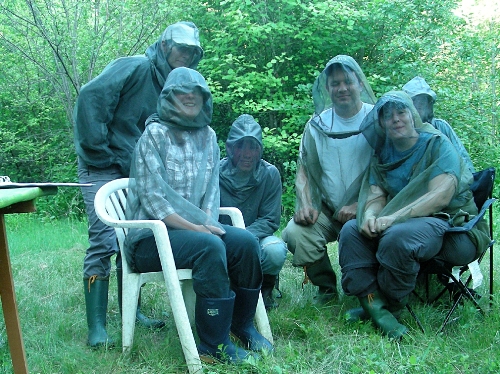|
McGILL BIRD OBSERVATORY |
||||||||||||||||||||||||||||||||||||||||||||||||||||
Welcome
to the McGill Bird Observatory weekly report.
Click here for a complete listing of our archives.
Banders-in-charge: Simon Duval, Gay Gruner Monitoring Avian Productivity and Survivorship (MAPS), Summer 2009 In 2009 MBO committed to operate a MAPS station on the MBO site for a minimum of five summers. Considering the high temperatures, voracious mosquito population and relative low capture rate of birds, why would the MBO undertake such a task? The data are important and of practical use. MAPS (run by the Institute for Bird Populations) takes our data and churns out indices of adult population size and post-fledging productivity as well as estimates of adult survival rate and population size. There are now over 1,000 MAPS stations across North America that have contributed data, roughly half of which are currently active annually; therefore the statistics are useful on local, regional and continent-wide levels for research purposes and developing land-management practices. The MAPS program has two major management objectives: to determine the cause of population declines, if any, and to devise habitat management actions and conservation strategies to reverse population declines. We should receive some practical strategies for managing the MBO habitat, i.e. making it better for birds. For further information on the MAPS program, visit the IBP page.
The MBO MAPS station (MBOM) operates nine mist nets placed in a horseshoe around the southern end of Stoneycroft Pond. Banding takes place on a single day during each of seven consecutive ten-day periods between late May and early August. In addition to operating mist nets, observers gather breeding bird evidence on all species heard or seen during each banding day.
In addition to the birds listed above, 5 Ruby-throated Hummingbirds were caught, but while they were promptly extracted, aged, and sexed, they were not banded. As a separate project led by Nicki Fleming with the support of a James L. Baillie Memorial Fund grant, another 45 nestlings (28 Red-winged Blackbird and 23 Tree Swallow) were banded this summer. Certainly not the high capture rate of the spring and fall migration monitoring programs! Nonetheless, it is a valuable program and we are developing a solid base of statistics on our breeding birds. It will be very interesting to see what trends emerge over the next five years. Thanks to Chris Murphy (accompanied at times by Gay Gruner or Barbara MacDuff), we also recorded census data throughout the season to supplement the observations from the MAPS program. This was valuable as the MAPS area is at the south end of MBO, so birds in the back ponds and woods could easily be overlooked. The total of 67 species observed during the summer season falls in the middle of the range of 57 to 77 from previous years. Included in this are six species that were observed only on the additional censuses: Great Blue Heron, American Woodcock, Red-tailed Hawk, Ring-billed Gull, Cliff Swallow, and Eastern Bluebird. Probable or confirmed breeding evidence was recorded for 31 species this summer.
31 of the 45 recaps were aged as adult birds, which indicates site fidelity is very strong among our breeding birds. The top recap highlights include a Song Sparrow banded in 2004 during MBO's fall pilot fall season, a Baltimore Oriole caught in the fall of 2005 and a Black-capped Chickadee netted during MBO's first winter banding season (December '05 to February '06). It was a great first season. Next year will be even better – when the volunteer notice goes out, please consider coming out for a day. Surprises can always happen – on our second-to-last session (23 July) we banded a Tennessee Warbler!
|






